- Home
- Michael McDowell
The Elementals
The Elementals Read online
THE ELEMENTALS
MICHAEL MCDOWELL was born in 1950 in Enterprise, Alabama and attended public schools in southern Alabama until 1968. He graduated with a bachelor’s degree and a master’s degree in English from Harvard, and in 1978 he was awarded his Ph.D. in English and American Literature from Brandeis.
His seventh novel written and first to be sold, The Amulet, was published in 1979 and would be followed by over thirty additional volumes of fiction written under his own name or the pseudonyms Nathan Aldyne, Axel Young, Mike McCray, and Preston MacAdam. His notable works include the Southern Gothic horror novel The Elementals (1981), the serial novel Blackwater (1983), which was first published in a series of six paperback volumes, and the trilogy of “Jack & Susan” books.
By 1985 McDowell was writing screenplays for television, including episodes for a number of anthology series such as Tales from the Darkside, Amazing Stories, Tales from the Crypt, and Alfred Hitchcock Presents. He went on to write the screenplays for Tim Burton’s Beetlejuice (1988) and The Nightmare Before Christmas (1993), as well as the script for Thinner (1996). McDowell died in 1999 from AIDS-related illness. Tabitha King, wife of author Stephen King, completed an unfinished McDowell novel, Candles Burning, which was published in 2006.
MICHAEL ROWE’s first novel Enter, Night was a finalist for both the Prix Aurora and the Sunburst Award. His second novel Wild Fell, a classic ghost story set in northern Ontario, has drawn comparisons to the work of Ann Radcliffe and Edgar Allan Poe and is a finalist for the 2013 Shirley Jackson Award. He lives in Toronto and is at work on his third novel. Visit him at www.michaelrowe.com.
BY MICHAEL MCDOWELL
NOVELS
The Amulet (1979)*
Cold Moon Over Babylon (1980)
Gilded Needles (1980)
The Elementals (1981)*
Katie (1982)
Blackwater (1983; 6 vols.)
Jack & Susan in 1953 (1985)
Toplin (1985)
Jack & Susan in 1913 (1986)
Clue (1986)
Jack & Susan in 1933 (1987)
Candles Burning (2006) (completed by Tabitha King)
PSEUDONYMOUS NOVELS
Vermilion (1980) (as Nathan Aldyne)
Blood Rubies (1982) (as Axel Young)
Cobalt (1982) (as Nathan Aldyne)
Wicked Stepmother (1983) (as Axel Young)
Slate (1984) (as Nathan Aldyne)
Canary (1986) (as Nathan Aldyne)
SCREENPLAYS
Beetlejuice (1988)
Tales from the Darkside: The Movie (1990)
The Nightmare Before Christmas (1993)
Thinner (1996)
* Available from Valancourt Books
THE ELEMENTALS
MICHAEL McDOWELL
With a new introduction by
MICHAEL ROWE
VALANCOURT BOOKS
The Elementals by Michael McDowell
First published as a paperback original by Avon Books in 1981
First Valancourt Books edition 2014
Copyright © 1981 by Michael McDowell
Introduction © 2014 by Michael Rowe
Published by Valancourt Books, Richmond, Virginia
Publisher & Editor: James D. Jenkins
20th Century Series Editor: Simon Stern, University of Toronto
http://www.valancourtbooks.com
All rights reserved. The use of any part of this publication reproduced, transmitted in any form or by any means, electronic, mechanical, photocopying, recording, or otherwise, or stored in a retrieval system, without prior written consent of the publisher, constitutes an infringement of the copyright law.
All Valancourt Books publications are printed on acid free paper that meets all ANSI standards for archival quality paper.
ISBN 978-1-941147-17-7
Also available as an electronic book.
Cover art by M.S. Corley
Set in Dante MT 11/13.2
CONTENTS
NOONDAY DEVILS
PROLOGUE
PART I
SAVAGE MOTHERS
CHAPTER 1
CHAPTER 2
CHAPTER 3
CHAPTER 4
CHAPTER 5
CHAPTER 6
CHAPTER 7
CHAPTER 8
CHAPTER 9
PART II
THE THIRD HOUSE
CHAPTER 10
CHAPTER 11
CHAPTER 12
CHAPTER 13
CHAPTER 14
CHAPTER 15
CHAPTER 16
CHAPTER 17
CHAPTER 18
CHAPTER 19
CHAPTER 20
CHAPTER 21
PART III
THE ELEMENTALS
CHAPTER 22
CHAPTER 23
CHAPTER 24
CHAPTER 25
PART IV
EYESIGHT
CHAPTER 26
CHAPTER 27
CHAPTER 28
CHAPTER 29
CHAPTER 30
CHAPTER 31
CHAPTER 32
CHAPTER 33
NOONDAY DEVILS
An Introduction to Michael McDowell’s THE ELEMENTALS
Re-reading Michael McDowell’s The Elementals again after my first reading of it, more than thirty years ago, what immediately returned to me was the vivid, annihilating heat of the Alabama summer at Beldame, the compound of three Victorian mansions perched on an ocean of glittering white sand on the Alabama shore—mansions that never existed in real life, but which were conjured to life by the writer whose novel you are now holding in your hands.
As someone not unfamiliar with gothic horror fiction, especially ghost stories, I am struck, today as in 1981, by that sunstruck Gulf shore brightness. Gothic horror fiction traditionally has depended on darkness and cold. The Elementals, among other things, a terrifying ghost story in which the ghosts are not exactly ‘ghosts’ in the accepted sense of the word, is notably unbound by that cliché, and its horrors are as likely to reveal themselves under the blazing noonday sun as they are to do so once the sun has gone down. The heat and the light in The Elementals is as much of a character in the novel as any member of the Savage or McCray families, as much of a character, indeed, as any of those three terribly-occupied houses at Beldame.
Michael McDowell, once hailed by Stephen King as “the finest writer of paperback originals in America today,” was a master of place. Other writers will have their own take on his aesthetic when it comes to place, but my (very joyous) task here is to introduce The Elementals, not any of his other novels that comprise one of the finest oeuvres in 20th century speculative fiction, and one of the books most formative to my aesthetic as a horror writer.
I read The Elementals in the late autumn of 1981. I had just graduated from boarding school and was trying to make a life for myself in Paris. As a Canadian living in Europe, I was already two geographic and cultural steps removed from the languid deep-south world of McDowell’s novel. Though a lifelong fan of horror fiction, in those pre-Internet days I knew nothing about the novel’s author, and had not read any of his other books yet.
What I did know was that, reading The Elementals in my apartment with the red-and-gold flocked wallpaper, while the cold Paris rain beat against the mottled glass of the apartment’s windows, I felt literally transported to high-ceilinged rooms where the heat baked in from outside, stopping breath, cutting off any hope of relief, while the shifting, living sands filled the rooms, assuming the shapes of the dead with a malign intelligence beyond the ken of the living—the world of Beldame.
And it stayed with me for more than thirty years, retreating into my subconscious, occasionally suggesting itself in dreams, and always feeling like
a place I visited, not a place I’d merely read about. The people I met there—the McCrays and the Savages—became people as real to me as those in my own life. Re-reading the novel in 2014 was more like a reunion of old friends than merely a revisiting of a book I’d read as a very young person on the brink of my own adult life.
Which is, after all, one of the hallmarks of a masterpiece.
What I know now, but didn’t know then, was that I was living through a certain later golden age of paperback horror fiction. There had been other such ages, but the flourishing of horror novels between the late ’70s and the late ’80s was a time of immeasurable richness. It was a time when it was not only possible, but likely, to pick up a book like The Elementals in all its southern gothic glory at the now-inconceivable price of $2.95. Perhaps the reason I never understood the disdain for horror fiction—literally never even connected to it as an abstract concept—is that my sensibility was nourished on work like this. The fact that they were in mass-market paperback didn’t matter, because with work like McDowell’s, which could just as easily have been published in hardcover by Knopf as southern gothic, the reader was in the hands of a gifted novelist. Of course there were hacks working in horror in the early ’80s, as in any era, but for anyone with a whit of discernment, there were the Michael McDowells and the Charles L. Grants. The sheer volume of the work being produced at that time, in that format, meant that it was also a moment when a horror reader (or aspiring horror writer) with taste had a treasure-trove through which to sift.
In an interview with critic Douglas E. Winter for his superb interview collection, Faces of Fear, McDowell famously quipped, “I would be perfectly willing if a publisher came up to me and said, ‘I need a novel about underwater Nazi cheerleaders and it has to be 309 pages long and I need fourteen chapters and a prologue.’ ”
It’s a terrific line, and certainly apropos for a writer of McDowell’s prodigious output, but the reason the line actually works it that McDowell’s writing never reads like the work of the author of underwater Nazi cheerleader novels.
Among other things, McDowell was a master of place, and The Elementals is an unequivocally southern novel. While it’s very true that Michael McDowell (who wrote about many different locales over the course of his career) was never bound by region, and that the success of The Elementals derives from his extraordinary gifts as a storyteller, not his extraordinary gifts as a southerner, it might also be true that the confluence of those two identities combined to create something extraordinary in this case.
It opens exquisitely with the funeral of the matriarch of an old Alabama family with its own particular tradition of bizarre burial rites. The matter-of-factness with which these rites are taken for granted by the clan is itself a preemptive cultural assertion. The entire opening sequence—the funeral, the dialogue between the various family members in the wake of the passing, the rite itself, a parrot that screams a jolting, terrifying refrain, “Savage mothers eat their children up!”—is in direct line of literary descent of the best of the southern gothic tradition, let alone the tradition of the very best horror fiction.
In the hands of a lesser writer, that aspect could be culturally distancing to non-southerners, or at least remarkable in a slightly jarring sense, but McDowell’s canvas, with its glorious descriptions and its artless, pitch-perfect dialogue, makes the experience of reading The Elementals an embracing one. The reader relaxes back into the prose, and travels.
The Alabama panhandle, he writes, which consists only of Mobile and Baldwin counties, is shaped rather like a heavily abscessed tooth. Mobile Bay represents the large element of decay that separates the halves, and at their northern extremities the counties are further divided by a complex system of meandering rivers and marsh.
Terrifying elemental spirits that can take on the shape and aspect of either the living or the dead, at any hour of the day or night, haunt Beldame itself, revealing themselves at first to India McCray, the visiting daughter of Luker McCray, one of the heirs. An assiduous follower of McDowell’s later work might think they had seen the bones of India McCray lying beneath the portrait of Lydia Deetz in Beetlejuice, a slightly jaded Upper West Side sophisticate wielding a Nikon as a shield between her own vulnerability and the often frightening and confusing world of adults around her.
But the world of Beldame and its three identical houses perched on an island of brilliant white sand on the edge of the Gulf hides horrors beyond anything that even India McCray can conceive.
In the words of Odessa Red, the family retainer housekeeper who serves as the novel’s “Van Helsing” figure, “What’s in that house, child, knows more than you know. What’s in that house don’t come out of your mind. It don’t have to worry ’bout rules, and behaving like a spirit ought to behave. It does what it does to fool you, it wants to trick you into believing what’s not right. It’s got no truth to it. What it did last week it’s not gone be doing today. You see something in there, it wasn’t there yesterday, it’s not gone be there tomorrow. You stand at one of them doors thinking something’s behind it—nothing’s behind it. It’s waiting for you upstairs, it’s waiting for you downstairs. It’s standing behind you.”
And all of this under a blazing Alabama summer sun where shade and shadow are hard to come by.
Earlier I mentioned that the sheer bounty of paperback horror fiction in the ’80s was a treasure. In many ways it was, but my own, very personal view is that, when the treasure became a glut, it killed it.
Eventually it became impossible for readers to immediately distinguish, on the surface, between work like the novels of Michael McDowell and his genuine peers, and the offal of increasingly bad fiction by talentless writers, published by publishers without discernment or taste, trying to stuff the maws of the book-buying public with what had basically become product. In spite of the same sorts of titles, the same sorts of covers, and even, in some cases, the same sorts of plots, the reading public eventually clued in to the fact that they were being sold a bridge. It wasn’t to say there weren’t still wonderful, literary horror novels being sold as paperback originals, just that it had become impossible to distinguish between them, and the sterling variety, until it was too late.
The republication of the best of these novels by Valancourt Books is an occasion for joy for any of us who truly loved that era, and miss it every time we visit what remains of the bookstores, let alone the remains of the bookstores that sell horror fiction.
In my opinion, this very noble and worthwhile undertaking is perfectly exemplified by this edition of Michael McDowell’s brilliant The Elementals. This is a horror novel for the ages, a 20th century haunted house that belongs in the company of Hill House, Hell House, or the Marsten House. Classic literary horror fiction simply doesn’t get better than The Elementals.
It has its peers, but Beldame and its inhabitants—both living and dead—cast their very own, very long, shadow.
MICHAEL ROWE
Toronto, Ontario
April 29, 2014
To lead us farther into darkness, and quite to lose
us in this maze of Error . . . the Devil maketh men
believe that apparitions, and such as confirm
his existence are either deceptions of sight,
or melancholy depravements of phansie.
— Sir Thomas Browne
Pseudodoxia Epidemica
In memory of
James and Mildred Mulkey
PROLOGUE
In the middle of a desolate Wednesday afternoon in the last sweltering days of May, a handful of mourners were gathered in the church dedicated to St. Jude Thaddeus in Mobile, Alabama. The air conditioning in the small sanctuary sometimes covered the noise of traffic at the intersection outside, but occasionally it did not, and the strident honking of an automobile horn would sound above the organ music like a mutilated stop. The space was dim, damply cool, and stank of refrigerated flowers. Two dozen enormous and very expensive arrangements had been set in
converging lines behind the altar. A massive blanket of silver roses lay draped across the light-blue casket, and there were petals scattered over the white satin interior. In the coffin was the body of a woman no more than fifty-five. Her features were squarish and set; the lines that ran from the corners of her mouth to her jaw were deep-plowed. Marian Savage had not been overtaken happily.
In a pew to the left of the coffin sat Dauphin Savage, the corpse’s surviving son. He wore a dark blue suit that fit tightly over last season’s frame, and a black silk band was fastened to his arm rather in imitation of a tourniquet. On his right, in a black dress and a black veil, was his wife Leigh. Leigh lifted her chin to catch sight of her dead mother-in-law’s profile in the blue coffin. Dauphin and Leigh would inherit almost everything.
Big Barbara McCray—Leigh’s mother and the corpse’s best friend—sat in the pew directly behind and wept audibly. Her black silk dress whined against the polished oaken pew as she twisted in her grief. Beside her, rolling his eyes in exasperation at his mother’s carrying-on, was Luker McCray. Luker’s opinion of the dead woman was that he had never seen her to better advantage than in her coffin. Next to Luker was his daughter India, a girl of thirteen who had not known the dead woman in life. India interested herself in the church’s ornamental hangings, with an eye toward reproducing them in a needlepoint border.
On the other side of the central aisle sat the corpse’s only daughter, a nun. Sister Mary-Scot did not weep, but now and then the others heard the faint clack of her rosary beads against the wooden pew. Several pews behind the nun sat Odessa Red, a thin, grim black woman who had been three decades in the dead woman’s employ. Odessa wore a tiny blue velvet hat with a single feather dyed in India ink.

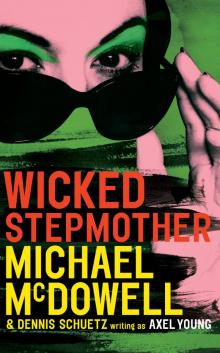 Wicked Stepmother
Wicked Stepmother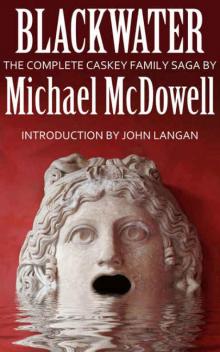 Blackwater: The Complete Caskey Family Saga
Blackwater: The Complete Caskey Family Saga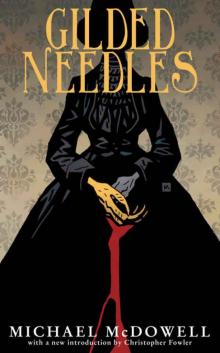 Gilded Needles (Valancourt 20th Century Classics)
Gilded Needles (Valancourt 20th Century Classics)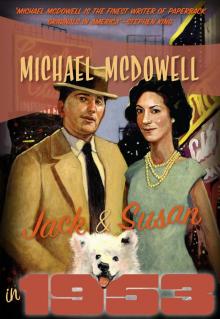 Jack and Susan in 1953
Jack and Susan in 1953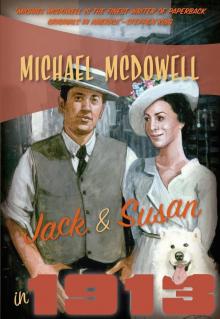 Jack and Susan in 1913
Jack and Susan in 1913 Rain
Rain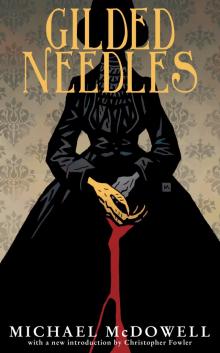 Gilded Needles
Gilded Needles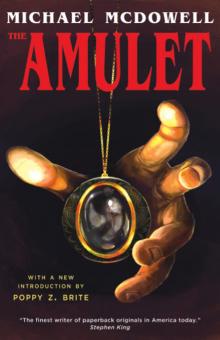 The Amulet
The Amulet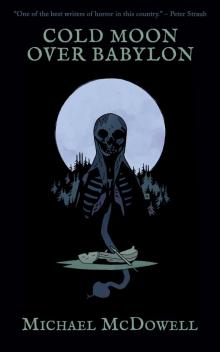 Cold moon over Babylon
Cold moon over Babylon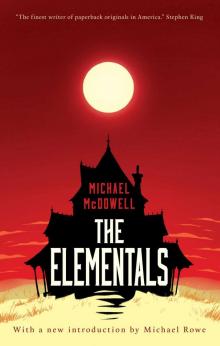 The Elementals
The Elementals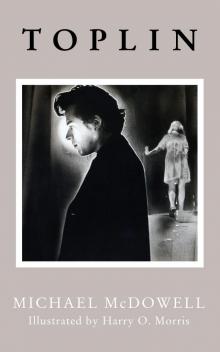 Toplin
Toplin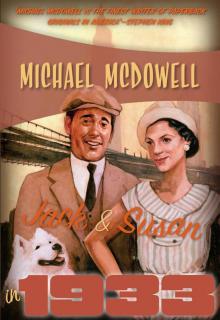 Jack and Susan in 1933
Jack and Susan in 1933 Katie
Katie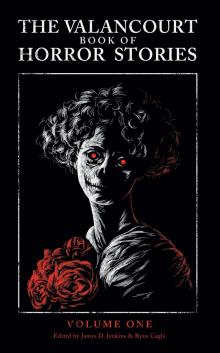 The Valancourt Book of Horror Stories
The Valancourt Book of Horror Stories